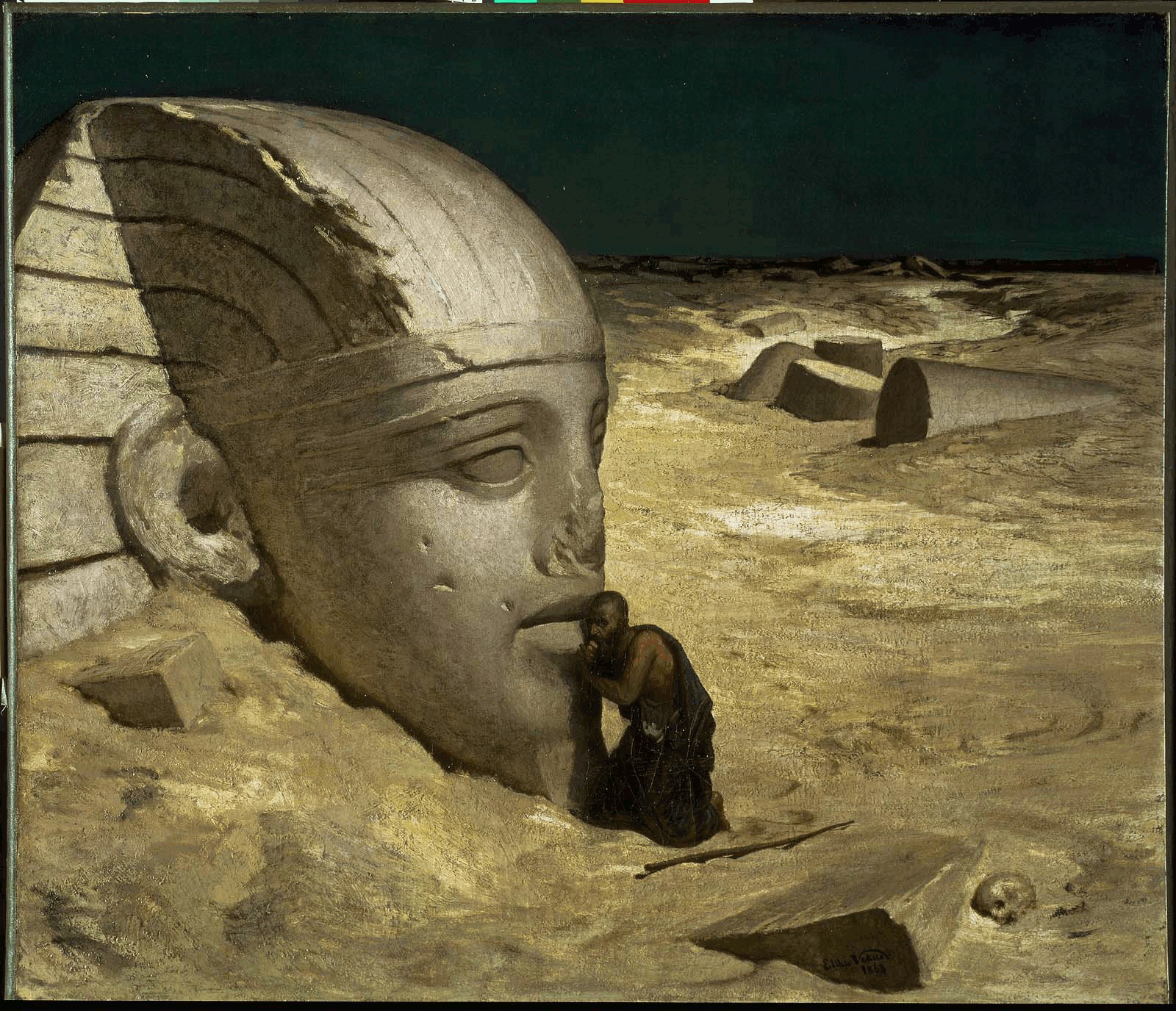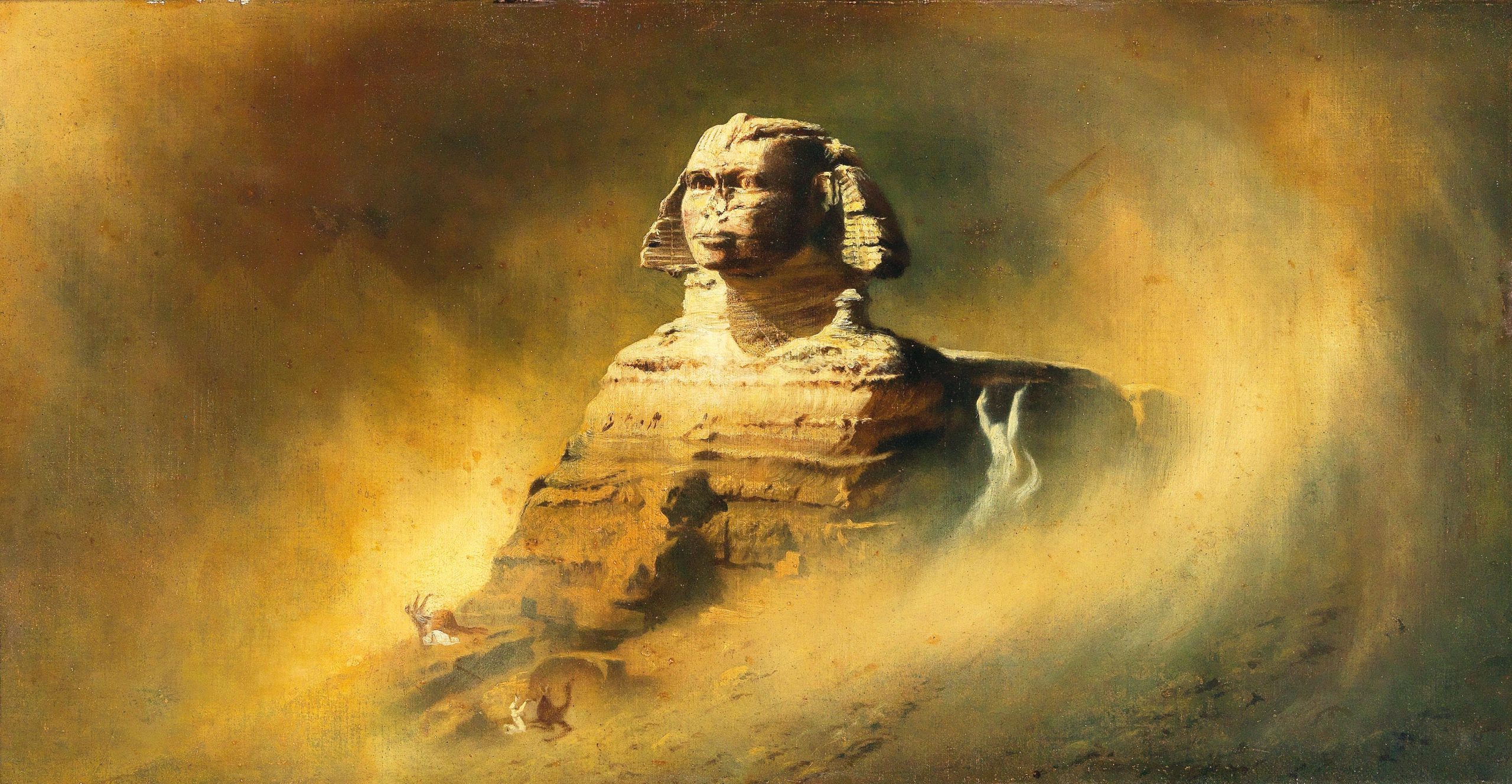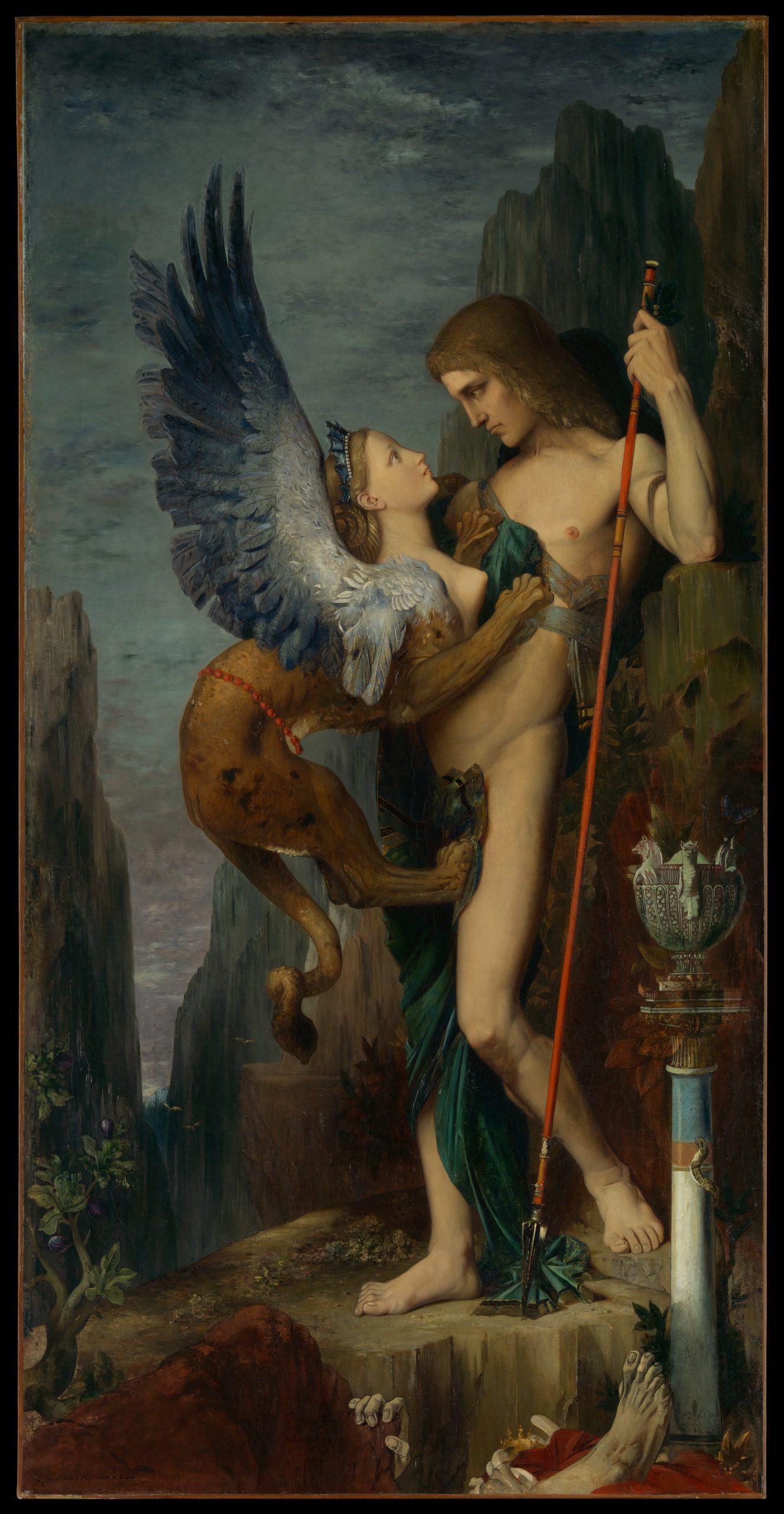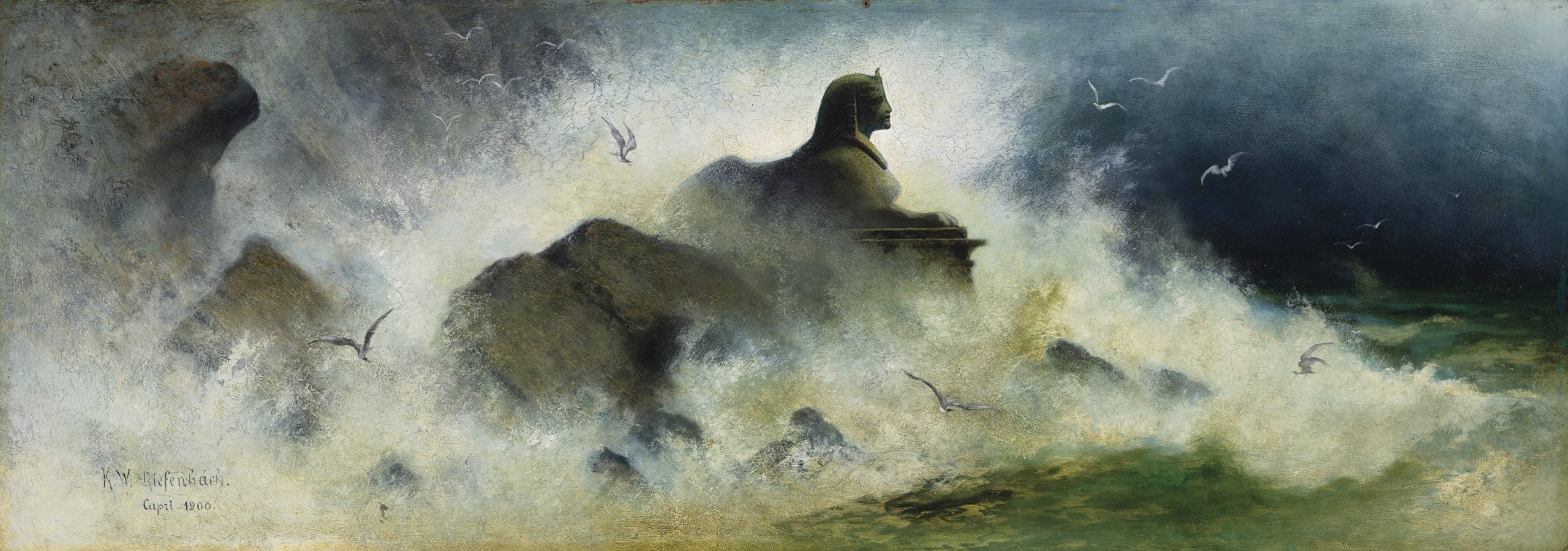18 Mythic Creatures on Land: The Sphinx
The Sphinx: Art Images, Poems, and Verses
With a history of secrecy, intriguing riddles and paradoxes, and aloofness, the sphinx has been viewed in many cultures as a symbol of knowledge. The sphinx continues to live in art, myth, and history. Beautiful and mesmerizing, the sphinx continues to live in art, myth, and history.
“In Greek tradition, the sphinx is a treacherous and merciless being with the head of a woman, the haunches of a lion, and the wings of a bird. According to Greek myth, she challenges those who encounter her to answer a riddle, and kills and eats them when they fail to do so. This deadly version of a sphinx appears in the myth and drama of Oedipus.In Egyptian mythology, in contrast, the sphinx is typically depicted as a man (an androsphinx (Ancient Greek: ανδρόσφιγξ)), and seen as benevolent, though with strength as ferocious as that of the Greek version. Both the Greek and Egyptian sphinxes were thought of as guardians, and statues of them often flank the entrances to temples.” (Retrieved March 26, 2023 https://en.wikipedia.org/wiki/Sphinx)
The Sphinx by Mathilda Blind (1841-1896)
Wanderer, behold Life’s riddle writ in stone,
Fronting Eternity with lidless eyes;
Of all that is beneath the changing skies,
Immutably abiding and alone.
The handiwork of hands unseen, unknown,
When Pharaohs of immortal dynasties
Built Pyramids to brave the centuries,
Cheating Annihilation of her own.
The heart grows hushed before it. Nay, methinks
That Man, and all on which Man wastes his breath,
The World, and all the World inheriteth,
With infinite, inexorable links
Grappling the soul; that love, hate, birth and death
Dwindle to nothingness before thee—Sphinx
Retrieved All Poetry Website, March 26, 2023.
https://allpoetry.com/poem/8513875-The-Sphinx-by-Mathilde-Blind


Excerpt of “The Sphinx” by Henry Howard Brownell, 1820-1872.
They glare—those stony eyes ! That in the fierce sun-rays
Showered from these burning skies,
Through untold centuries
Have kept their sleepless and unwinking gaze.
Since what unnumbered year
Hast thou kept watch and ward
Suggested by a drawing of Flaxman.
“And near the pyramids, more wondrous and more awful than
all else in the land of Egypt, there sits the lonely Sphynx.
Comely the creature is, but the comeliness is not of this world”
And o’er the buried land of Fear,
So grimly held thy guard?
No faithless slumber snatching
No rest that mortals crave
Like some fierce hound long watching
Above her master’s grave.
No fabled Shape art thou ! On that thought- freighted brow,
And in those smooth weird lineaments we find,
Though traced all darkly, even now,
The relics of a Mind : And gather dimly thence
A vague, half-human sense
The strange and sad Intelligence,
That sorrow leaves behind.
Dost thou in anguish thus
Still brood o’er Oedipus? And weave enigmas to mislead anew….
(Retrieved Internet Archive. March 26, 2023 https://ia800501.us.archive.org/6/items/poems07brow/poems07brow.pdf)

Excerpt from The Mythology Book: Big Ideas Simply Explained (Shulamit Ambalu, 2018, DK Penguin Random House, p.p. 86-87).
“On the road to Thebes, Oedipus (King of Thebes) met a self-important dignitary, who demanded that Oedipus make way for him. He quarreled with the man and killed him, not realizing that he was King Laius, his father. When he then fell in love with the King’s widow, Jocasta, Oedipus had no idea she was his own mother.
Any man who hoped to marry Jocasta and become the new king of Thebes had to solve a riddle
Posed by the human-headed, lion-bodied, and bird-winged creature known as the Sphinx. ‘What,’ the Sphinx asked, ‘goes on four legs in the morning, two legs at noon, and three legs in the evening?’ Oedipus did not hesitate. ‘Man,’ he replied. As an infant, man crawls on all fours, then walks upright, finally in old age, he shuffles along with the help of a stick.’” (Ambula, 2018, p. 87).

Excerpt from “The Great Pyramid” by Herman Melville (1819-1891)
Your masonry—and is it man’s?
More like some Cosmic artisan’s.
Your courses as in strata rise,
Beget you do a blind surmise
Like Grampians….
Morn’s vapor floats beneath your peak,
Kites skim your side with pinion weak:
To sand-storms battering, blow on blow,
Raging to work your overthrow,
You-turn your cheek.
All elements unmoved you stem,
Foursquare you stand and suffer them:
Time’s future infinite you dare,
While, for the past, ‘tis you that wear,
Eld’s diadem…”
From:
Ryan, D.P. (Ed.).(2016). Ancient Egypt in poetry (p.47). The American University of Cairo Press.
For more information about the artist Karl Wilhelm Diefenbach, please open the link below.
https://en.wikipedia.org/wiki/Karl_Wilhelm_Diefenbach

“https://commons.wikimedia.org/wiki/File:Fernand_Khnopff_-_Caresses_-_Google_Art_Project.jpg” by Google Arts and Culture is licensed under CC0 by 1.0.
For more information about the artist and his symbolist paintings, please open the link below:
https://www.apollo-magazine.com/modern-art-belgian-fernand-khnopff/
The Sphinx
Ralph Waldo Emerson – 1803-1882
The Sphinx is drowsy,
The wings are furled;
Her ear is heavy,
She broods on the world.
“Who’ll tell me my secret,
The ages have kept?–
I awaited the seer,
While they slumbered and slept…
Animals who Inspired Beautiful Art and Poetry
The White Doe of Rylstone

Excerpt from “The White Doe of Rystone” by William Wordsworth (1807).
“…And through yon gateway, where is found,
Beneath the arch with ivy bound,
Free entrance to the church-yard ground;
And right across the verdant sod
Toward the very house of God;–
Comes gliding in with lovely gleam.
Comes gliding in serene and slow,
Soft and silent as a dream,
A solitary doe!
White she is as lily of June,
And beauteous as the silver moon
When out of sight the clouds are driven;
And she is left alone in heaven;
Or like a ship some gentle day
In sunshine sailing far away,
Or glittering ship, that hath the plain
Of ocean for her own domain.” -William Wordsworth
Internet Archive Audio Recording: https://archive.org/details/rylstone_2006_librivox
Excerpt retrieved November 22, 2022
https://www.rylstoneproject.com/the-white-doe-of-rylston

